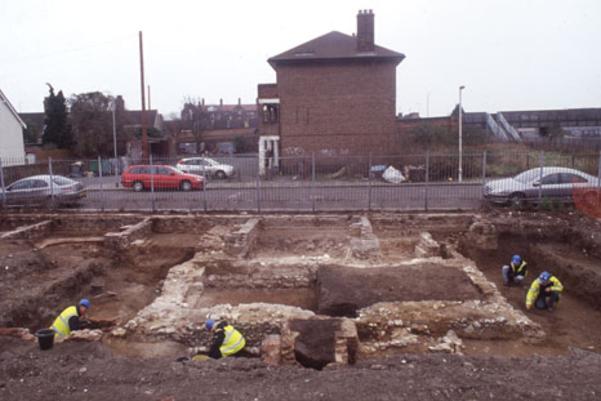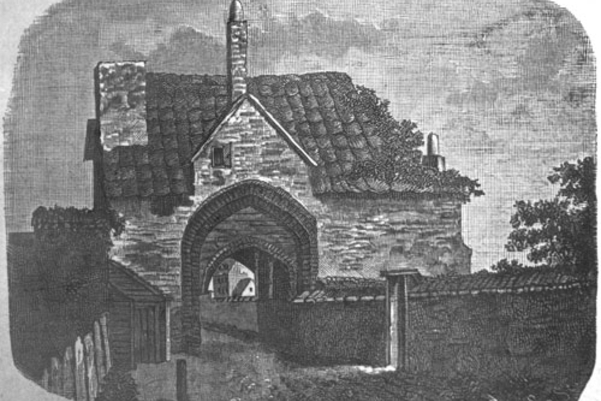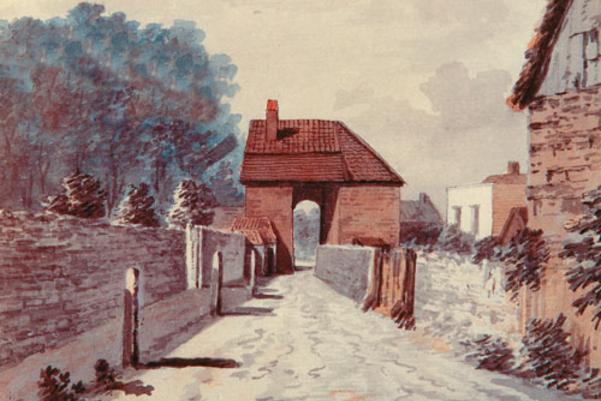Community excavation reveals the Great Gate of Stratford Langthorne Abbey
A series of archaeological investigations by MOLA at two adjoining sites in West Ham revealed remains of the wealthy medieval abbey of St Mary Stratford Langthorne (founded in 1135). The sites, at Abbey Gardens, Bakers Row and Abbey Road Docklands Light Railway Station, were investigated by MOLA between 2007 and 2010.
From 1147 until its suppression in 1538, the abbey was a Cistercian monastery. The Cistercians, sometimes known as White Monks because of their plain undyed habits, were renowned for their austerity and their devotion to prayer and work. Their lifestyle was hard and uncompromising – even the wearing undergarments was forbidden!
Among the abbey remains uncovered during the excavations were parts of the great drain, a foundation and a grave on the site of the church, a cellar or a small fishpond and possibly part of the infirmary, while planting pits provided evidence for monastic gardens on the eastern edge of the abbey precinct. However, the archaeological highlight was undoubtedly a community excavation carried out by local residents on an overgrown plot of wasteland on the north side of Bakers Row (now Abbey Gardens). The dig was organized by Newham Council and MOLA with the aim of uncovering the remains of a medieval stone building first discovered by archaeologists in the early 1970s, but then reburied for their protection. It was hoped that after consolidation, the masonry would be robust enough for permanent display.
When first discovered, the building was thought to be the abbey gatehouse or Great Gate, which after the Dissolution was converted into a dwelling and survived until about 1825. However, the building was soon reinterpreted as an abbey guesthouse, for it appeared to be too small to be the gatehouse, and in any case it did not seem to straddle the access road to the abbey (perpetuated today by Bakers Row).
During the community dig, teams of volunteers worked on exposing and cleaning the ruins of the building. Most participants had no previous digging experience, but were guided by MOLA archaeologists. Some attended for just one session, while others were regulars. One stalwart, a night-shift worker, came every afternoon. New arrivals would be given a health-and-safety talk and site tour before setting to work with trowels, brushes, hoes and shovels. The dig attracted considerable local interest, and was viewed by residents, schoolchildren and the press. Throughout the project, Newham Council gave practical support by taking bookings, lending artifacts from the 1970s dig for object handling and providing some excellent display boards.
Work in a previously unexcavated strip on the south side of the medieval building revealed stone walls extending out towards Bakers Row. From this it was clear that the building was much larger than had been thought, and that it had been constructed in two phases. It was also evident that the building would have crossed the line of the access road to the abbey precinct. So it was the gatehouse after all.
After the Dissolution the gatehouse was further extended and modified for use as a secular dwelling. Brick cesspits were built next to it in the 16th/mid 17th century and the mid 17th/18th century. A stretch of the great drain was rebuilt on a smaller scale, possibly in the late 16th or 17th century, and continued in use into the 19th century. Other post-medieval features included several 16th- to 18th-century pits, the remains of a 17th-century brick building, garden walls, a possible well, moat fills and a late 18th-century/early 19th-century brick cesspit possibly associated with the converted gatehouse. The latest features were the remains of Victorian terraced houses fronting onto Bakers Row. The results of the excavation are to be published in the Transactions of the London and Middlesex Archaeological Society and London Archaeologist.


